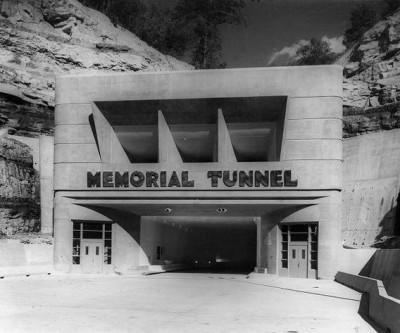Work begun 1952 | Length 854 m | |
 | ||
Operator | ||
The Memorial Tunnel is a 2,802 feet (854 m) two-lane vehicular tunnel that formerly carried the West Virginia Turnpike through/under Paint Creek Mountain in Standard, West Virginia in Kanawha County. Closed to interstate traffic since 1987, the tunnel serves as the Center for National Response for military first responders to train for various situations that may arise in such a location without alarming the general public.
Contents
Map of Memorial Tunnel Pl, Eskdale, WV 25075, USA
The tunnel's bypass is not unlike the Pennsylvania Turnpike bypassing the Laurel Hill Tunnel in 1964, followed by the bypass of the Rays Hill and Sideling Hill Tunnels in 1968.
History
Construction of the Memorial Tunnel commenced in 1952 and it officially opened to traffic on November 8, 1954, at a final cost of $5 million. Its construction required the movement of 91,000 cubic yards (70,000 m3) of earth, and it was the first tunnel in the nation to have closed-circuit television monitoring. By 1976, upgrades to the Turnpike commenced, and by 1983 all but the Memorial Tunnel had been completed. The tunnel created a bottleneck – the 4-lane, divided highway turnpike had to merge into the two-lane, two-way traffic configuration of the tunnel, which also had a lower speed limit. This resulted in traffic backups during periods of increased traffic, such as holiday travel seasons. Instead of upgrading and expanding the tunnel, a 1.72 miles (2.77 km) extension was constructed to serve as a bypass for both the tunnel and the Bender Bridge. Costing $35 million to complete, 10,000,000 cubic yards (7,600,000 m3) of earth were removed in addition to 300,000 tons of coal being removed from the mountain. The final vehicle would pass through the tunnel on July 7, 1987, and it would subsequently close for use for pass-through vehicular traffic.
Between 1992 and 1995, the Department of Transportation entered a deal with the state to utilize the abandoned tunnel for smoke, fire and ventilation experiments. These experiments were carried out to design better developed ventilation systems for the tunnels being constructed as part of the Big Dig in Boston; the results of the tests were also incorporated into the design of the Channel Tunnel. These experiments also resulted in the Federal Highway Administration allowing jet fans for ventilation in tunnel construction, which was a significant change to their original ventilation designs. The lasting legacy of the Memorial Tunnel Fire Test Program is in both changes in ceilings materials used in tunnel construction as well in the approved use of jet fans for ventilation during construction.
By 2000, the tunnel had been selected as the location where the Center for National Response would conduct anti-terrorism training exercises. The current facilities offered in the center include:
Groups from around the country are sending personnel to West Virginia to train in the facility. In all, about 160,000 first responders have been trained by West Virginians.
